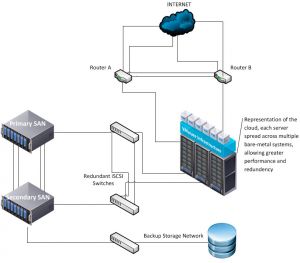Our Platform

The Cloud Infrastructure
The cloud infrastructure underlying the Redwax Cloud Hosting platform is fully redundant. To break it down...
- Multiple active internet connection & routers.
- N+1 Hypervisor clusters with multiple connections to each router.
- Redundant iSCSI switches connect the hypervisorts to the SAN's via multiple physical links.
- The SAN's are clustered together to mirror each other and each employs Raid 10 arrays providing the fast, reliable basis for the cloud platform.
- The backup network then backups the cloud every hour, ensuring this traffic does not congest our primary network.
Managing Data & Data Security
A milti-layered system has been implemented to maximise the protection of arguable the most important element within the data centre - Your Data!!!
Simply employing RAID does not necessarily protect your data and simply backing up isn't going to fulfil the needs of a swift recovery.
We believe that employing more safeguards when it comes to your data, rather than fewer, is the obvuious choice and matters such as these should not be overlooked when choosing a hosting provider.
Protection Layer 1: RAID10
Anyone who has owned a computer knows that the most likely cause of data loss is the result of a failed hard disk. RAID (Redundant Array of Inexpensive Disks) makes it possible to counteract the very probably disk failure that occurs with hard disks. There are a number of RAID levels each with their advantages and disadvantages. RAID 0 spreads data across 2 disks, increasing speed but actually reducing redundancy by half! RAID 1 makes a complete copy of a disk and keeps it in sync on another disk = 2 copies of your data. RAID 10 uses both systems enabling both speed and reliability.
When a disk fails in RAID, it is flagged and can be changed without anybody noting any effect on performance, no downtime, not nothing. In fact, because of the resilience of RAID 10, it would be possible for as many as half the disks in the array to fail (very unlikely it is fair to say) without causing issue.
The most likely item to fail in a computing system is a hard drive, due to the moving parts. By using RAID systems, we can prevent an individual drive failure having any impact.
Protection Layer 2: Fail-over SAN
To protect against the unlikely possibility of a total loss on the Primary SAN, either through a sudden failure of more disks than the array can sustain or the entire SAN suffers catastrophic hardware failure, there is a backup Secondary SAN. Data is constantly written to both SAN's, effectively creating a mirror and provides the same seamless fail-over you would expect in a RAID system!
Protection Layer 3: Data Corruption / Write-hole Protection
Any data storage system will, over time, introduce corruption to data stored in the system. Worryingly, this happens without anybody every noticing, until it is far too late.
To mitigate this, block level check-sums are employed to ensure data consistency at every level. Even rarely accessed data is interrogated in this way to ensure long term consistency.
Most providers do not offer this degree of data management!
Protection Layer 4: Local Backup
All services include full system backups. Leveraging the power of each SAN, snapshots are taken every hour and retained according to the following schedule:
- Hourly backups which are kept for 24 hours
- Daily backups which are kept for 7 days
- Weekly backups which are kept for 4 weeks
The backups are taken on the SAN's kept on the backend storage network ensure the continuous smooth running of the system!
Protection Level Tier 5: Physically Diverse Backup Location
To mitigate against a total loss of facility in the primary data centre,backups are further kept at an alternate yet similarly secured data centre in the midlands
The Storage Area Network - Performance
What storage systems do we provide?
Cloud hosting makes it possible to separate storage and processing, enabling better fault tolerance and scalability. It is all to easy for performance to take a hit though and so focusing on performance is essential!
Again, a multi-layer system is in place to ensure that performance is consistent and fast!
- Read Performance: The SAN's make use of build-n dedicated RAM which caches regularly needed data. The ingenious way in which this is done enables over 80% of read requests to be served from RAM = very fast! Solid State Drive's are also used and serve a further percentage of the data, leaving somewhere in the region of 10% of requests requiring access to be made to the physical hard disks. Because these disks are doing relatively little, the speed from them is also exceptional.
- Write Performance: Write operations are typically slow in many disk storage systems. Much less so in a Solid State Disk System. Write operations make use of a highly optimised cache allowing for contiguous data-write to be formed before the data is then committed efficiently to disk. This reduces the I/O write nightmare suffered by many SAN based systems.
